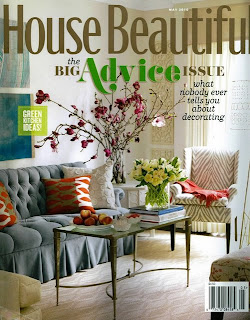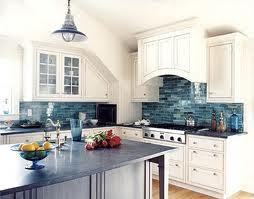 Daniele Busca lives for Scavolini. After spending an hour chatting with him and touring the showroom and US headquarters in Soho I can understand why. Daniele is the Manager and Creative Director who makes it all work on this side of the pond. The new location which has been open since last October is enjoying a brisk business and I think it's largely due to Daniele's knack for tweaking this Italian product for an American market. "American kitchens are generally bigger", he says, "and where you would have an island in America we might have a kitchen table instead in Italy." Another major difference is the appliances. American refrigerators are almost always bigger." White still reigns.
Daniele Busca lives for Scavolini. After spending an hour chatting with him and touring the showroom and US headquarters in Soho I can understand why. Daniele is the Manager and Creative Director who makes it all work on this side of the pond. The new location which has been open since last October is enjoying a brisk business and I think it's largely due to Daniele's knack for tweaking this Italian product for an American market. "American kitchens are generally bigger", he says, "and where you would have an island in America we might have a kitchen table instead in Italy." Another major difference is the appliances. American refrigerators are almost always bigger." White still reigns. I thought it was interesting to hear that home owners are requesting glossy finishes and architects prefer the matte look. A artful mixing of textures, both tactile and visual, is also important. I asked Daniele to define a trend. He says, "in the end a trend is what sells." The showroom spans two floors. Displays were designed in Italy and re-designed by Daniele for an exact fit both in size and taste for the US market. "Americans also tend to prefer symmetry in kitchen design," he added. Scavolini is a family business based in Pesaro, Italy and has been the largest cabinet manufacturer in Italy since 1984 with 40 dealers in the US. This year marks the company's 50th anniversary. Clientele for the New York location is largely an international group who keep an apartment in New York City as well as elsewhere. This year Scavolini will roll out seven new models. Four new displays are already in the works for this new showroom. The Tetrix line, as seen at IDS, designed by internationally-famous British designer Michael Young, is also being featured. Tetrix is not yet on display here but Daniele's sending me some pix to share with you. Designers may be interested to know that Scavolini has developed their own design and pricing program. Scavolini is very involved in the Green movement. I was surprised to hear that the manufacturing facility in Italy is 85% powered by solar panels and they are planning to make it 100% by the end of the year. All cabinet boxes and door panels are made from 100% recycled fire retardant and water resistant wood. All lacquers used are water-based. Scavolini is involved in the local community offering the showroom for fund raising events organized by trade associations and design schools. Generally speaking, a Scavolini kitchen can be yours for from about 10K to upwards of 90K.
I thought it was interesting to hear that home owners are requesting glossy finishes and architects prefer the matte look. A artful mixing of textures, both tactile and visual, is also important. I asked Daniele to define a trend. He says, "in the end a trend is what sells." The showroom spans two floors. Displays were designed in Italy and re-designed by Daniele for an exact fit both in size and taste for the US market. "Americans also tend to prefer symmetry in kitchen design," he added. Scavolini is a family business based in Pesaro, Italy and has been the largest cabinet manufacturer in Italy since 1984 with 40 dealers in the US. This year marks the company's 50th anniversary. Clientele for the New York location is largely an international group who keep an apartment in New York City as well as elsewhere. This year Scavolini will roll out seven new models. Four new displays are already in the works for this new showroom. The Tetrix line, as seen at IDS, designed by internationally-famous British designer Michael Young, is also being featured. Tetrix is not yet on display here but Daniele's sending me some pix to share with you. Designers may be interested to know that Scavolini has developed their own design and pricing program. Scavolini is very involved in the Green movement. I was surprised to hear that the manufacturing facility in Italy is 85% powered by solar panels and they are planning to make it 100% by the end of the year. All cabinet boxes and door panels are made from 100% recycled fire retardant and water resistant wood. All lacquers used are water-based. Scavolini is involved in the local community offering the showroom for fund raising events organized by trade associations and design schools. Generally speaking, a Scavolini kitchen can be yours for from about 10K to upwards of 90K.









 Thank you to Daniele for hosting my visit. I really enjoyed chatting with him. I asked a million questions and he was up to the task, warm and most gracious. If you're ever in Soho stop in and see for yourself. Tomorrow I will be back with more from New York.
Thank you to Daniele for hosting my visit. I really enjoyed chatting with him. I asked a million questions and he was up to the task, warm and most gracious. If you're ever in Soho stop in and see for yourself. Tomorrow I will be back with more from New York.
SHOW SOME SKIN IN YOUR KITCHEN
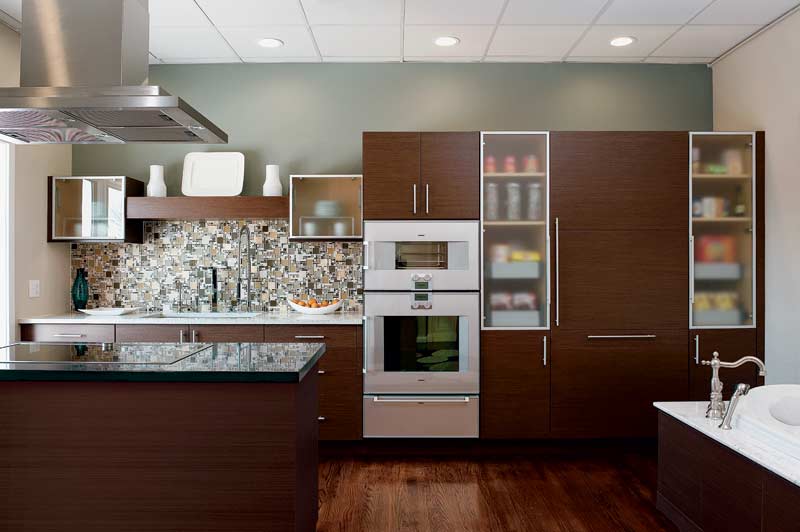 Don't get excited. Skins are what we sometimes call wood veneers, or super thin sheets of material used to cover cabinet doors or panels instead of using solid wood. As clean lines and contemporary styling continues to increase in popularity, surfaces themselves become the ornamentation and focal interest in a kitchen. The use of interesting wood grain veneers which are both beautiful and unique, is an excellent way to make a simple slab door stand out.
Don't get excited. Skins are what we sometimes call wood veneers, or super thin sheets of material used to cover cabinet doors or panels instead of using solid wood. As clean lines and contemporary styling continues to increase in popularity, surfaces themselves become the ornamentation and focal interest in a kitchen. The use of interesting wood grain veneers which are both beautiful and unique, is an excellent way to make a simple slab door stand out.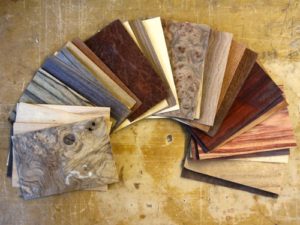
 Many of my clients are surprised to learn that this is can actually be a more expensive option compared to a solid wood door. There are a couple of reasons for this. One is that these veneers, or skins, are often made from exotic wood and secondly this can be a labor intensive process, thus the increased cost. The advantage being you can "control" the wood grain, so to speak, creating patterns that match up with each other. So if the unexpected randomness of natural wood grain makes your pits sweat this could be a good alternative for you.Another option if exotic wood veneers are too rich for your blood is something called "engineered wood veneers". These are man made skins that replicate the exotics using not-so-exotic woods. The material cost is a lot less and in many cases it's hard to tell the difference.
Many of my clients are surprised to learn that this is can actually be a more expensive option compared to a solid wood door. There are a couple of reasons for this. One is that these veneers, or skins, are often made from exotic wood and secondly this can be a labor intensive process, thus the increased cost. The advantage being you can "control" the wood grain, so to speak, creating patterns that match up with each other. So if the unexpected randomness of natural wood grain makes your pits sweat this could be a good alternative for you.Another option if exotic wood veneers are too rich for your blood is something called "engineered wood veneers". These are man made skins that replicate the exotics using not-so-exotic woods. The material cost is a lot less and in many cases it's hard to tell the difference. If you still love more traditional styling, veneers can still be useful for you. A traditional 5 piece door benenfits greatly from a center panel that is veneer rather than solid wood. The reason is that the veneer is applied to a dense MDF substrate that will not expand and contract the way solid wood does, thus the center panel will not ever swell cracking open the seams or shrink resulting in a lose rattling center panel.One of my favorite traditional doors made here at Brendan Donovan Furniture & Cabinet Co. is this Sapele Mahogany door with a Rosewood veneer center panel.Another way to get the look without blowing your budget is to mix it up. Just use the veneer on, for example, your upper cabinet doors. The more intricate the graining the stronger the statement. In other words, a little goes a long way. Too much and it becomes busy and you lose the concept of focal point.
If you still love more traditional styling, veneers can still be useful for you. A traditional 5 piece door benenfits greatly from a center panel that is veneer rather than solid wood. The reason is that the veneer is applied to a dense MDF substrate that will not expand and contract the way solid wood does, thus the center panel will not ever swell cracking open the seams or shrink resulting in a lose rattling center panel.One of my favorite traditional doors made here at Brendan Donovan Furniture & Cabinet Co. is this Sapele Mahogany door with a Rosewood veneer center panel.Another way to get the look without blowing your budget is to mix it up. Just use the veneer on, for example, your upper cabinet doors. The more intricate the graining the stronger the statement. In other words, a little goes a long way. Too much and it becomes busy and you lose the concept of focal point.
 If your kitchen design involves round radius shapes it's going to involve wood veneer which can be bent and moulded to conform as needed. Another beautiful effect can be achieved through the use of marketry, or inlay. In researching this post I came across the amazing work of Juli Morsella. Talk about adding a little art to your kitchen! In addition, Juli is committed to using reclaimed woods, eco-friendly materials and she donates 10% of her earnings to environmental causes.
If your kitchen design involves round radius shapes it's going to involve wood veneer which can be bent and moulded to conform as needed. Another beautiful effect can be achieved through the use of marketry, or inlay. In researching this post I came across the amazing work of Juli Morsella. Talk about adding a little art to your kitchen! In addition, Juli is committed to using reclaimed woods, eco-friendly materials and she donates 10% of her earnings to environmental causes.
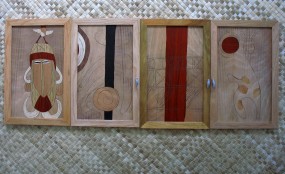
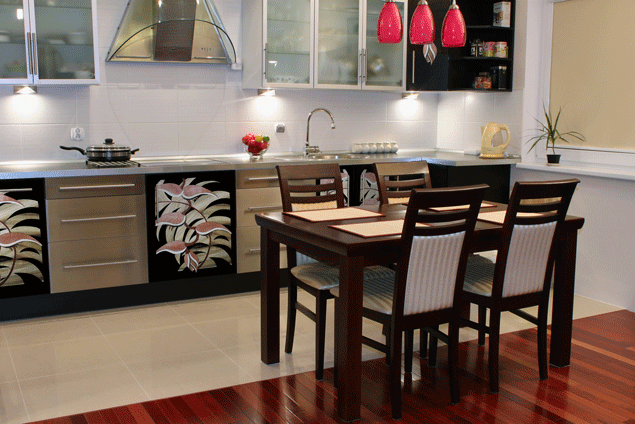 If you're interested in using wood veneers (or not) for your kitchen I would love to hear from you! Congrats to Amy Parrag of Eye See Pretty. She is the winner of the Orgaline drawer organizer giveaway!
If you're interested in using wood veneers (or not) for your kitchen I would love to hear from you! Congrats to Amy Parrag of Eye See Pretty. She is the winner of the Orgaline drawer organizer giveaway!
HOUSE BEAUTIFUL GOES GREEN WITH HOLIDAY!
House Beautiful Magazine featured Holiday Kitchens Cabinets in their May issue. I wrote about the project in my May 7th blog post. I love the Holiday Kitchens line because they are truly a great value for a custom US manufactured cabinet. This Kitchen of the Month, which happens to be in the residence of Robert Kennedy Jr. and his family, showcases green, eco-friendly products. Designer Robin Wilson used recycled wood, formaldehyde-free glues, low-VOC paints and stains. With a little bit of thought you can incorporate some or all of these things into your new kitchen. The best news is that it is even becoming more affordable to do so. If you're not ready for the "full-on-granola-lifestyle", you can go green at your own comfort level. Even simple habits like turning off the the lights and recycling your cans and cardboard can be a good start. If you want to go further, there's always a new Holiday kitchen!

